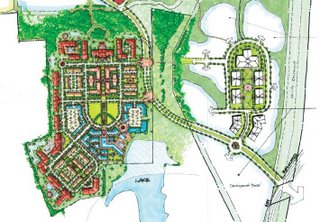 One of the recurring debates on this blog addresses the extent to which growth should “pay its own way” — or, to be more specific, the extent to which developers should cover the capital costs of public investments such as road improvements, schools, fire, police, libraries and other public facilities — a number that could reach $90,000 to $100,000 per dwelling unit in Northern Virginia.
One of the recurring debates on this blog addresses the extent to which growth should “pay its own way” — or, to be more specific, the extent to which developers should cover the capital costs of public investments such as road improvements, schools, fire, police, libraries and other public facilities — a number that could reach $90,000 to $100,000 per dwelling unit in Northern Virginia.
There’s a raging case study in the South Dulles area of Loudoun County, where Greenvest is proposing some $800 million in proffers and $200 million in Community Development Authority funding over the 20-year life of the project. Just think of that: One billion dollars in private-sector contributions, over and above the taxes that developers, business tenants and homeowners normally pay in taxes to fund the cost of local government.
In my latest column, “Growth that Pays for Itself,” I delve into the pros and cons of the Greenvest proposals. What I find ironic is that Greenvest has taken on so much public cost that it increases the risk that its projects will fail financially — at least its critics see it that way. It’s kind of a damned-if-you-do, damned-if-you-don’t thing. If the proffers are too small, you’re not paying your fair share. If they’re too big, you run the risk of failure. That makes it pretty tough to get anything built.
To my mind, the best argument against the project is one the critics I talked to didn’t raise: Greenvest has not designed its South Dulles projects from the ground up with transportation-efficiency in mind. To Greenvest’s credit, the projects are mixed use, with pedestrian-friendly elements, and Greenvest is willing to proffer some 15 transit buses. Also to Greenvest’s credit, development in the South Dulles area would provide elements of what Ed Risse calls a balanced community, with a mix of residential, commercial and amenities — even a satellite campus of George Mason University (land donated by Greenvest) and an Inova hospital facility on a neighboring property.
But the prospect of gridlock in that corner of Northern Virginia is so great that any development in any location must make transportation mitigation a top priority. That includes not only contributing to road improvements, as Greenvest proposes, but an aggressive traffic demand management program — encompassing, walking, biking, vans, buses, carpools and telework — to reduce the number and length of car trips.
I will continue to track the Greenvest proposal as it plays out this fall.
(Rendering shows the proposed Arcola project town center and GMU satellite campus.)


